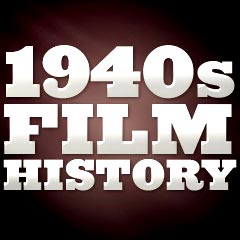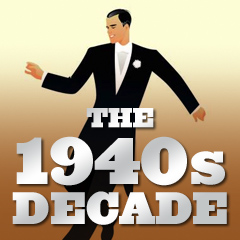 |
Part 4 Film History of the 1940s Part 1, Part 2, Part 3, Part 4, Part 5, Part 6 Film History by Decade Index | Pre-1920s | 1920s | 1930s | 1940s | 1950s | 1960s 1970s | 1980s | 1990s | 2000s | 2010s |

|
|
Val Lewton and Horror:
Further horror masterpieces pairing the talents of Tourneur and Lewton included one of their earliest productions - the modestly-budgeted, artistic horror thriller I Walked With a Zombie (1943). It was set on the voodoo-infested island of Haiti and derived from the classic Jane Eyre tale. The last film in Tourneur's trio of films with Lewton was the truly terrifying The Leopard Man (1943) with a frightening off-screen 'leopard' attack on a young girl. Lewton also went on to produce The Seventh Victim (1943) (directed by Mark Robson) and the sequel The Curse of the Cat People (1944) (directed by Gunther Von Fristch and Robert Wise). Universal's Horror Films and More: The frightening horror film Frankenstein Meets the Wolf Man (1942) featured two of Universal Studios' classic monsters, portrayed respectively by a miscast Bela Lugosi and Lon Chaney, Jr.. Universal's House of Dracula (1945), the sequel to House of Frankenstein (1944), starred Lon Chaney, Jr. as the Wolf Man (again), and John Carradine as the vampire. There were four sequels to the original 1932 Mummy film (starring Boris Karloff as Kharis) between 1940 and 1944, with Lon Chaney, Jr. in three of the four films: The Mummy's Hand (1940), The Mummy's Tomb (1942), The Mummy's Ghost (1944), and The Mummy's Curse (1944). One of the scariest films of the 40s was the haunted house classic The Uninvited (1944), starring Ray Milland and Ruth Hussey as a brother and sister who move into a mysterious house on the Cornish coast and soon detect cold spots and the smell of mimosa. The First Appearance of Major Cartoon Characters: Animated films' cartoon characters Bugs Bunny, Tom and Jerry, Woody Woodpecker, Mighty Mouse, and Casper (among many others) made their film debuts in the 40s decade. The short film A Wild Hare (1940) introduced the wise-cracking, carrot-chomping Bugs Bunny, soon to be one of Warner Bros' biggest stars. Tom & Jerry, created by Hanna & Barbera, were debuted by MGM in Puss Gets the Boot (1940). (Tom was called Jasper and Jerry didn't have a name yet.) Woody Woodpecker first appeared in the cartoon Knock, Knock (1940) distributed by Universal Studios, in which he bedeviled another Lantz character Andy Panda. The next year, the popular Woody became a starring character in The Cracked Nut (1941), and began to replace the waning Oswald the Rabbit. A caped super-rodent named Mighty Mouse was introduced in the Terrytoons short The Mouse of Tomorrow (1942), noted for saying: "Here I come to save the day!" Paramount's theatrical cartoon The Friendly Ghost (1945), debuted the character of Casper. The characters of the RoadRunner ("Accelerati Incredibulis") and the Coyote ("Carnivorous Vulgaris") were debuted in the short animated film Fast and Furry-ous (1949). The Golden Age of Disney Feature Film Animation:
Disney's charming live-action feature film (with animated sequences) Song of the South (1946), was based on the Uncle Remus' tall-tale stories of Brer Rabbit by Joel Chandler Harris. Although it was a commercial success, the film was criticized by the NAACP in 1946 for "the impression it gives of an idyllic master-slave relationship", but was still nominated for Best Scoring of a Musical Picture, and received an Oscar for Best Song ("Zip-a-Dee-Doo-Dah") - and an honorary Oscar to African-American James Baskett for his portrayal of Uncle Remus.
Captain Marvel: Also appearing in 1941 was the first film appearance of a comic strip and comic book hero - Captain Marvel (Tom Tyler), in an episodic serial entitled The Adventures of Captain Marvel (1941). It was one of the finest comic-to-film adaptations ever made. Preston Sturges' Social-Comedy Satires: Sturges made a string of brilliant screwball comedies and witty satires including eight signature films (seven were comedies) between 1940 and 1944, his peak period of production:
After Sturges left Paramount in 1944 to find independence, he became embroiled with financial difficulties and suffered creative exhaustion. He only completed four more pictures (until his death in 1959). He also directed/wrote the box-office flop The Sin of Harold Diddlebock (1947) (aka Mad Wednesday), co-produced with Howard Hughes (and the first and only film by California Pictures), starring silent film star Harold Lloyd (after almost a ten-year hiatus and in his final film) in the lead role portraying an unemployed, inhibited clerk who was enlivened and redeemed by a special alcoholic drink termed the Diddlebock. One of Sturges' final films was the successful comedy Unfaithfully Yours (1948), about a symphony conductor (Rex Harrison) who fantasized about killing his allegedly unfaithful wife (Linda Darnell). Sturges' last American/Hollywood film was the western comedy The Beautiful Blonde From Bashful Bend (1949) with Betty Grable, and he directed his final film in Europe, The French, They Are a Funny Race (1956). 1940s Westerns: Howard Hughes' notorious and independently-produced adult-western The Outlaw (1943) faced close scrutiny by the Hays Office (and Joseph Breen), due to its exploitation of star Jane Russell's prominently-uncovered 36D" chest in her debut film by Hollywood huckster Russell Birdwell. Salacious advertising with lines such as: "What are the two great reasons for Jane Russell's rise to stardom?" added to the lurid sensationalism and kept the film from being widely circulated. In addition, pin-up shots of big-busted Russell rolling around in the hay had the desired effect at the box office (especially among WWII GIs). One of the film's most vulgar stunts, also orchestrated by Birdwell, was to have skywriting planes fly over San Francisco where they spelled the film's title followed by two giant circles -- each dotted in the center. Hughes defied the Hayes Production Code (reportedly this was the first US film to do so), and sued the MPAA organization, but eventually backed down. Hughes postponed its opening until 1943 when it was given a limited release (one-week run), then withdrew it, and re-released it three years later in 1946 in a cut version, and then again in 1947. The eventual release of the mediocre, fictional film ended up as an example of triumphant ballyhooing and film marketing. A Cecil B. DeMille Western-style "Gone With The Wind" epic with Gregory Peck and Jennifer Jones as libidinous rivals/lovers, Duel in the Sun (1946), nicknamed "Lust in the Dust," was released by David O. Selznick. At seven million dollars, it was the costliest film to date. A Western-style "Mutiny on the Bounty," Howard Hawks' Red River (1948), often considered one of the greatest westerns ever made, was a straight-forward, visually-striking tale of a cattle boss father/adopted son controversy (John Wayne vs. Montgomery Clift) during the first cattle drive up the newly-opened Chisholm Trail. Another of the best westerns ever made was William Wellman's The Ox-Bow Incident (1943) about two drifters (Henry Fonda and Henry Morgan) who witness the vigilante lynching of three innocent men. John Ford's Westerns: During the 1940s, director John Ford embarked on his most prolific era with an expanded string of classic Westerns to chronicle America's pioneer past. His award-winning (and most-nominated) films were his three social dramas in the 40s, not his westerns:
Ford then filmed a classic western about Wyatt Earp (Henry Fonda) and the OK Corral titled My Darling Clementine (1946) featuring Victor Mature as Doc Holliday. His three entries at the end of the decade, in a celebrated "Cavalry Trilogy" each with his favorite male lead (John Wayne) were:
Part 1, Part 2, Part 3, Part 4, Part 5, Part 6 |